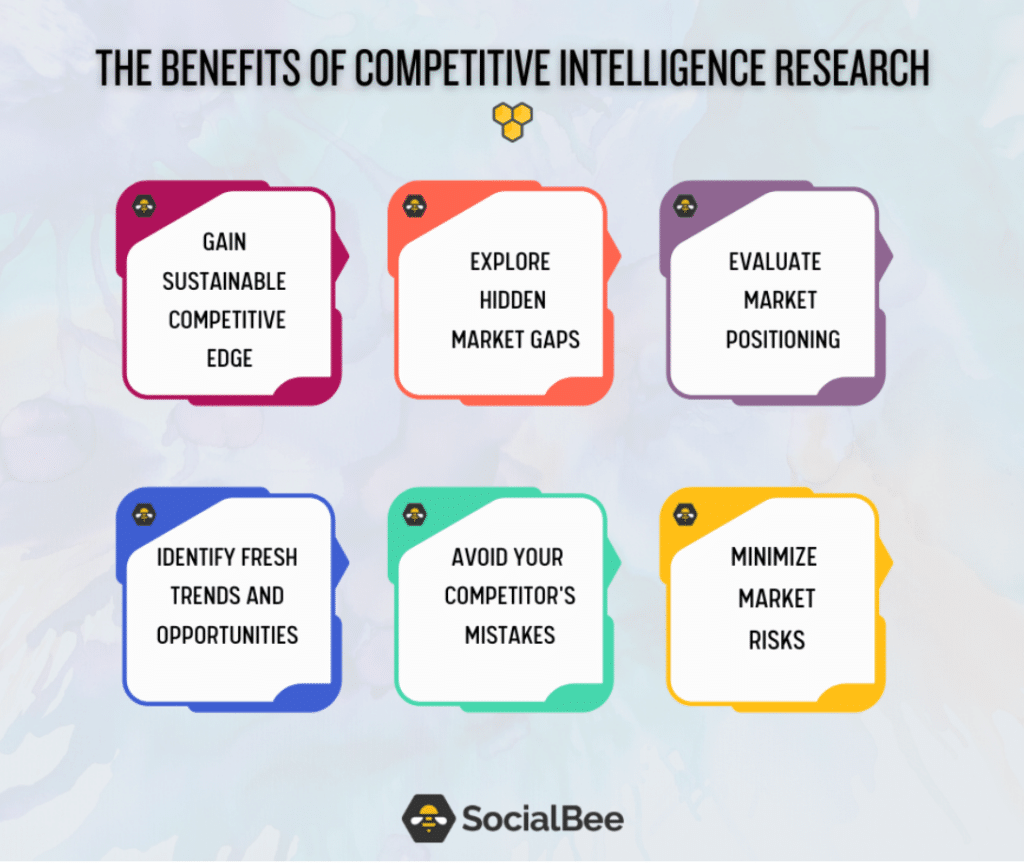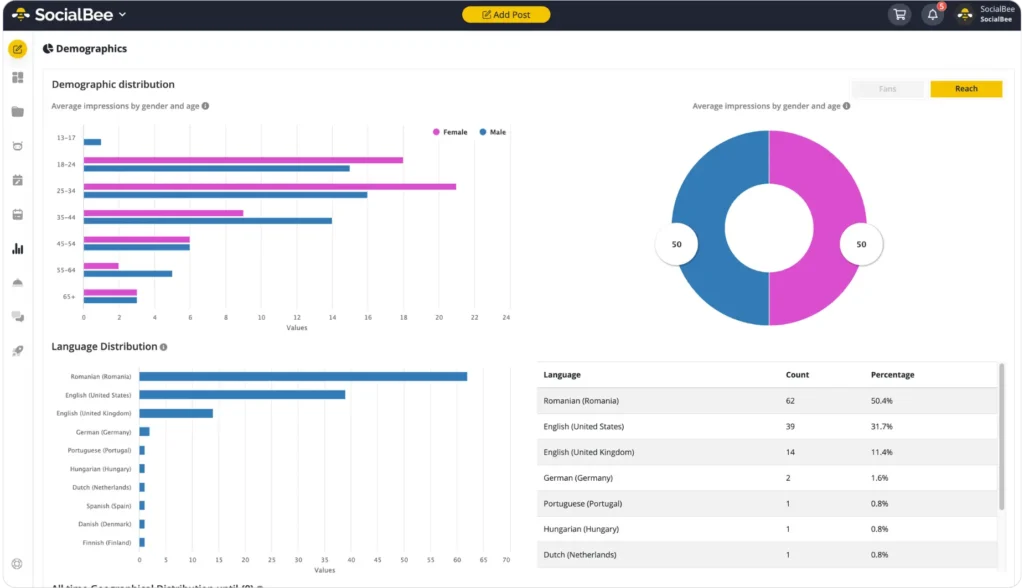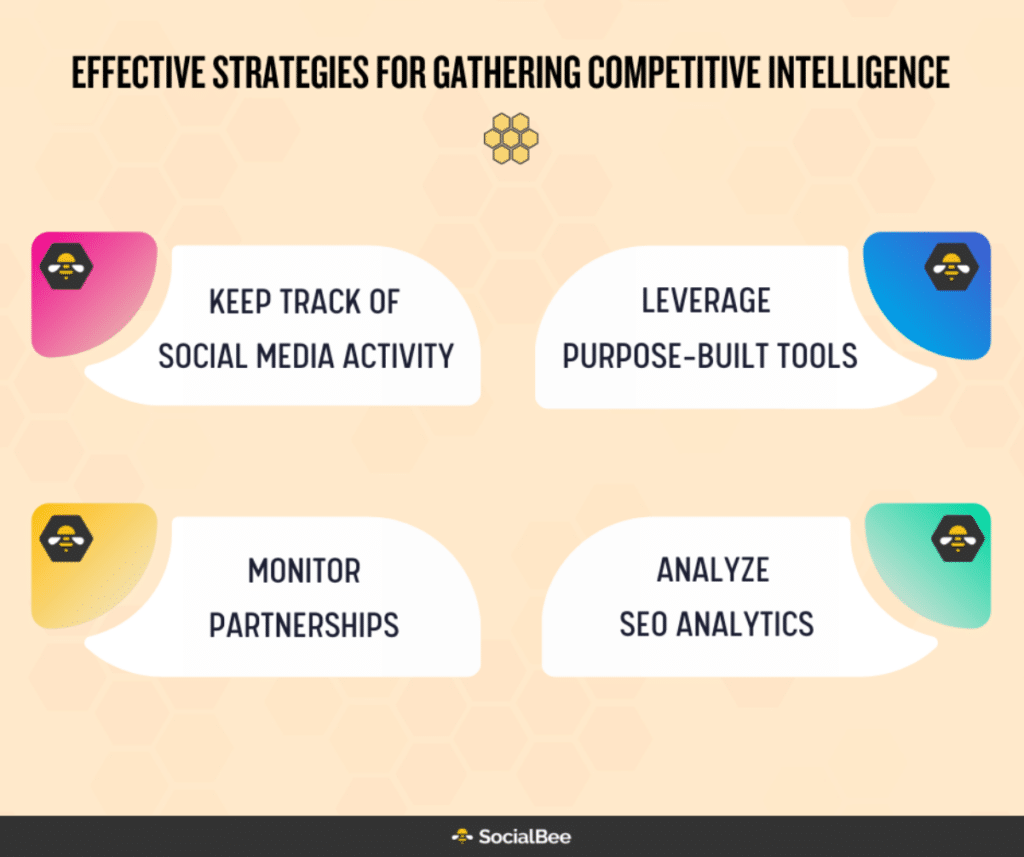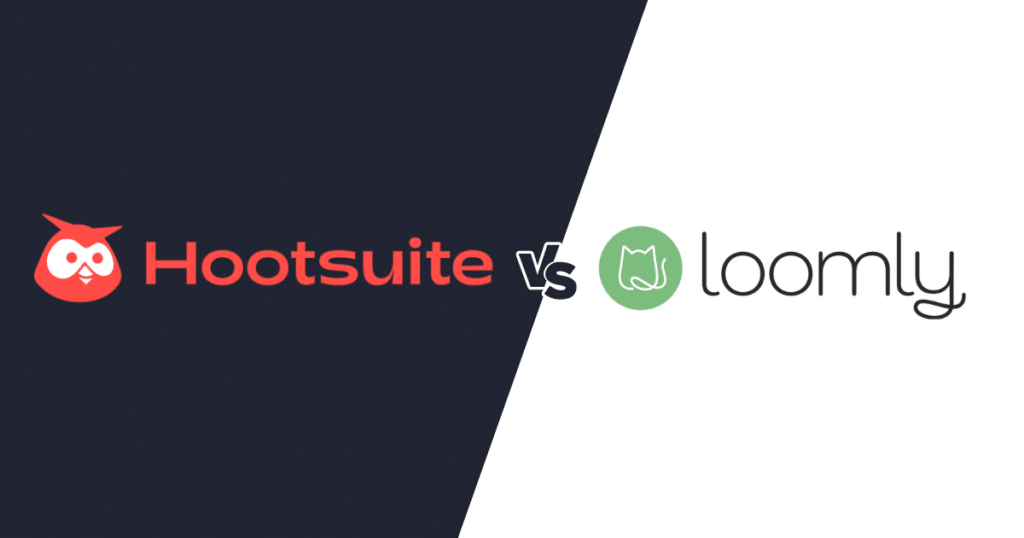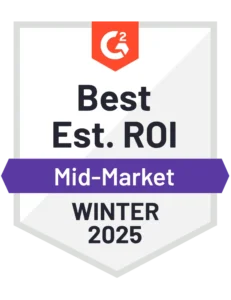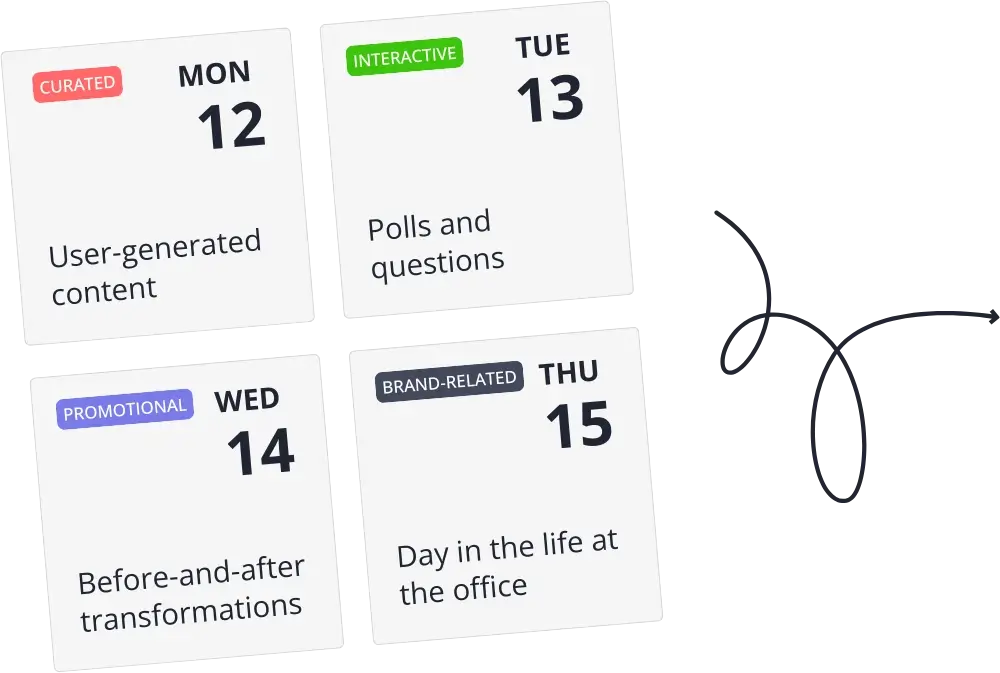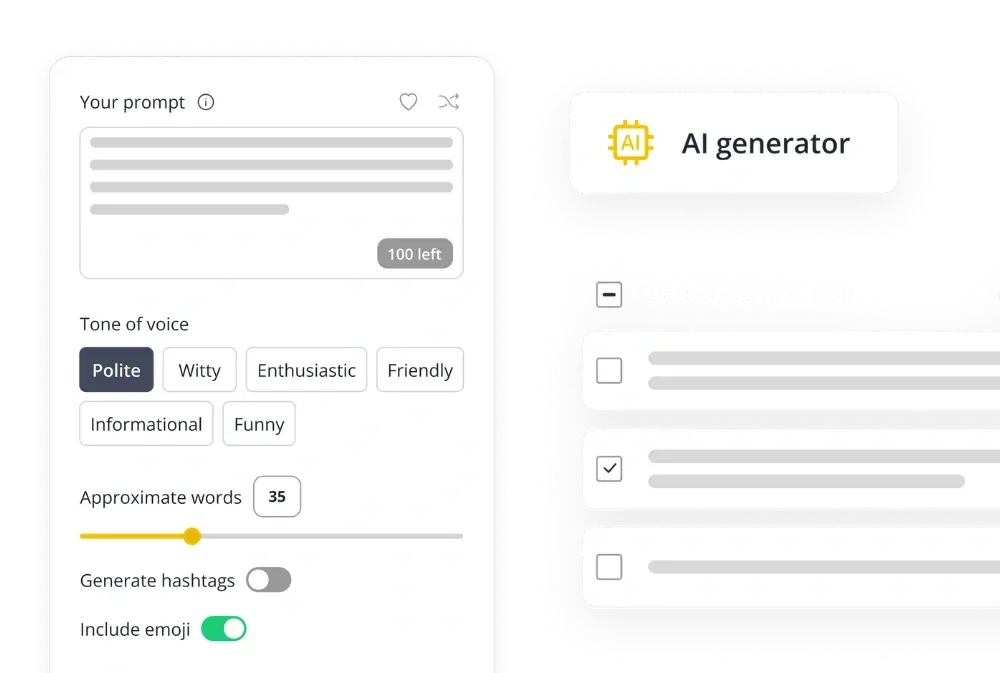
Guest Author
In today’s fast-paced business world, the big players are going all-in on market intelligence research resources to maintain their edge in the marketplace, a concept known as competitive intelligence.
And contrary to all the stereotypes swirling around it, competitive intelligence is much more than just keeping tabs on your competitors’ tweets and Facebook posts.
So if you want to explore how competitive intelligence information can level up your business strategy, then you’ve come to the right spot!
By the end of this post, you’ll know what competitive intelligence is, its role, and how an efficient competitive intelligence research strategy can help you optimize your social media campaigns.
Sounds good? Time to dive into competitive intelligence!
We’re SocialBee LABS SRL, part of WebPros. We use the information you provide to share relevant content and product updates, as outlined in our Privacy Policy. You can opt out anytime.
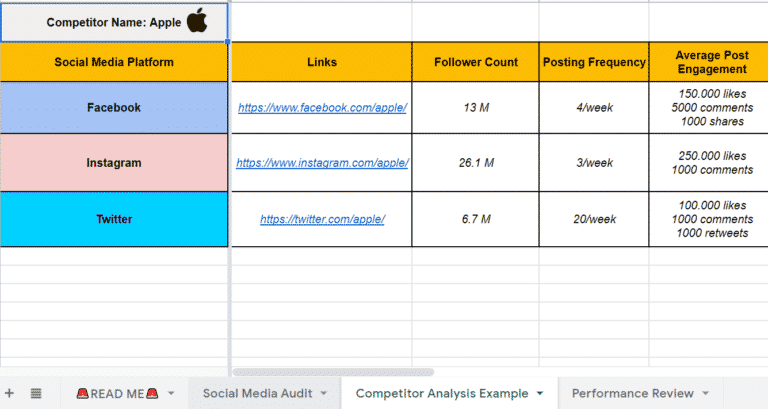
Short Summary:
- Competitive intelligence involves analyzing and collecting data about competitors to gain insights into their tactics and strengths.
- Tactical and strategic competitive intelligence practices help marketing and sales teams in making both short-term and long-term business decisions.
- Competitive intelligence is crucial in today’s data-driven business world, enabling businesses to understand customer needs, evaluate market positioning, and identify trends and opportunities in this competitive environment.
- Practical steps to leverage competitive intelligence in social media campaigns include identifying competitors, monitoring their social media profiles, analyzing follower demographics, and measuring campaign performance.
- If you want to gather competitive intelligence data, this can be done through social media activity analysis, purpose-built tools, monitoring partnerships, analyzing SEO analytics, and using tools like SocialBee, SEMrush, and Ahrefs.
- A competitive intelligence strategy is essential for gaining a competitive edge, providing insights for differentiation, innovation, risk mitigation, and empowering sales teams.
What Is Competitive Intelligence?
Competitive intelligence refers to the process of analyzing and collecting valuable data about competing businesses in your industry. It allows you to gain insights into their tactics and identify their strengths, weaknesses, and everything in between, that can help you expand and preserve your competitive advantage.
But the truth is that surface-level information, like what you can observe on their website or social media profiles, only tells you part of the story, and it will take you more in-depth work to extract the full potential of competitive intelligence.
That’s precisely why you need to deeply slice and dice this collected data to uncover patterns and trends that may have slipped under the radar before or identify a new opportunity that your competitors might not have stumbled upon yet. So no market gaps get missed this way!
Types of Competitive Intelligence
Companies typically choose between two main types of competitive intelligence:
- Tactical: This type of competitive intelligence allows businesses to make well-informed decisions and deal with short-term concerns, like securing market share or optimizing short-term profits.
- Pricing comparisons: Analyzing competitors’ prices for similar products or services, often by reviewing publicly available pricing documents or invoices.
- Product features: Evaluating features of competitors’ new product releases.
- Promotion and advertising analysis: Studying the promotional strategies of competitors, i.e. social media platforms or competitor websites.
- Supply chain information: Tracking potential disruptions or advantages in competitors’ supply chains.
- Sales tactics: Understanding competitors’ approaches to sales and customer acquisition.
- Strategic: With the help of the strategic path, competitive intelligence professionals tackle and solve long-term issues, such as potential financial risks, technological updates, and evolving market trends.
- Market entry and expansion: Analyzing potential new markets or regions for growth opportunities.
- Technological advancements: Assessing competitors’ investment in new technologies.
- Mergers and acquisitions (M&A) opportunities: Identifying potential firms for partnership or acquisition.
- Legislative and regulatory forecasts: Predicting potential regulatory changes and their impacts.
- Consumer behavior trends: Spotting and understanding long-term shifts in consumer preferences.
The Importance of Competitive Intelligence in Business Strategy
No secrets here: in today’s world, data has control over everything around us – and that gets more obvious in business strategies.
We’ve reached a point where decisions are mainly driven by data sources such as customer reviews, ratings, and social media analytics, to name a few.
But what if we tell you that leveraging competitive intelligence research can be just as impactful as the data you’re collecting from these sources?
Competitive intelligence will empower you to speak your customers’ language, hit their pain points, and offer real solutions for their sales questions. And if you want to take it a step further, dig into your competitors’ messages. You’ll gain some serious insights into the type of clients they’re after.
Even better! Competitive intelligence can perfectly reveal how your competitors are performing, and from there, you can pick up their moves to get similar results. On the other hand, if their stuff is good but not hitting the mark, maybe that place isn’t right for you.
Best of all? Competitive intelligence research offers a multitude of advantages that extend beyond large corporations. It empowers companies of varying sizes and diverse industries to boost sales, craft strategic plans, and maintain a competitive edge.
The Many Benefits of Competitive Intelligence Research
If you want your business to have a winning marketing and positioning strategy, your best bet is to know exactly where your product stands in the market, adapt to your customer needs, and be ready for unexpected market changes.
Now, you might be thinking, how can competitive intelligence help with all of those things? Well, that’s what we’re about to show you!
These are the benefits of integrating competitive intelligence in your business strategy:
- Gain a sustainable competitive edge
- Explore hidden market gaps
- Evaluate your market positioning
- Identify fresh trends and opportunities
- Avoid your competitor’s mistakes
- Minimize market risks
1. Gain a Sustainable Competitive Edge
It’s hardly surprising to realize that in highly competitive industries, the distance separating you from your competitors is diminishing by the day. However, fret not, for competitive intelligence research is your salvation.
Gathering insights about fellow market participants not only equips you to anticipate their future market strategies but also functions as an early warning system.
The point of doing this is to stay one step ahead in your decision-making process and always get that first-mover advantage, regardless of the industry you’re in.
2. Explore Hidden Market Gaps
Numbers don’t lie— Crayon reveals that over 90% of businesses are planning to invest in competitive intelligence, and it’s not really hard to see why!
Competitive intelligence isn’t just about protecting your bottom line in the long run. It will also help you identify opportunities you might have missed otherwise.
So when you’re on top of the market updates, competition buzz, and what’s popping on social media, you get a bigger picture of the whole market, so no chance that hidden gems get missed out this way.
3. Evaluate Your Market Positioning
Every business out there wants to know where it stands in the market compared to its competitors and in which areas it needs to catch up. Who wouldn’t be curious?
And what better thing to do than use competitive intelligence?
Competitive intelligence does all the heavy lifting for you. All you’ve got to do is compare and check the services you and your competitors are bringing to the table using your own set of standards.
4. Identify Fresh Trends and Opportunities
You probably notice how things keep changing in the market, so sorry to tell you if you’re not up on the latest trends and opportunities, you’ll be lagging behind before you know it.
That’s when you realize that implementing a savvy competitive intelligence plan is your go-to option to keep track of what’s buzzing in the market.
Let’s suppose you’re running a SaaS website, and you spot one of your prospects eyeing a new feature– let’s call it AI image generation. In a case like this, you’ve got to act quickly and make that feature a priority. This way, meet your target audience’s changing needs, and your website will stay slick and user-friendly.
5. Avoid Your Competitor’s Mistakes
It may sound cliché, but it’s safe to say that sometimes, holding back and seeing how a new product or feature performs for your competitors first can actually save you a lot of money in the long term, and that’s when competitive intelligence comes in handy.
So if you’re unsure about your next move, it’s always wise to take a step back and weigh the pros and cons. It might just help you decide with a clear mind whether to go all in or not.
This prevents you from making the same strategic mistakes they did and helps you better allocate your resources as you move ahead.
6. Minimize Market Risks
Time is money, and so are resources like data and research. Just imagine if you could predict your competitors’ moves long before they happened. You’ll already be in on it whenever they improve their app version, introduce a new feature, or reveal a new partnership.
This is precisely what competitive intelligence does–it minimizes market risks and prevents possible business troubles way before they hit.
Now, of course, you can’t anticipate every little thing your competition will do. Getting a clue about their potential moves means you can act faster when they approach your customers.
Practical Steps to Leverage Competitive Intelligence in Social Media Campaigns
We’ve done our share of explaining what competitive intelligence is and why companies should use it for their business strategies. Now let’s move on to the fun part.
This section will walk you through the nitty-gritty of leveraging competitive intelligence in your social media campaigns. Ready for some hands-on work?
These are the:
- Audit your marketing strategy
- Recognize your competitors, both direct and indirect
- Monitor their social media profiles
- Analyze follower demographics
- Monitor competitor’s campaigns
- Measure the benchmark performance
- Keep the data up-to-date
1. Audit Your Marketing Strategy
Before diving into the realm of competitive intelligence, it’s crucial to first understand and define your brand’s own marketing strategy. By auditing your current plan, you’ll identify areas of strength, potential weaknesses, and opportunities for growth. This will serve as a baseline against which you can measure and compare your competitors’ strategies.
Here are some steps to effectively audit your marketing strategy:
- Define your goals: What are the primary objectives you wish to achieve with your social media campaigns? This could range from increasing brand awareness, boosting sales, generating leads, or driving website traffic.
- Evaluate your content: Take a close look at the type of content you’re producing. Is it engaging and valuable to your target audience? Is there a mix of educational, entertaining, and promotional content?
- Analyze engagement metrics: Use tools to monitor the performance of your posts. How many likes, shares, comments, and followers are you gaining? These metrics can provide insights into what’s working and what’s not.
- Understand your audience: Who are you trying to reach? Know the demographics, preferences, and behaviors of your target audience. This knowledge will ensure your content resonates with them.
- Review your platforms: Are you present on the right social media platforms? Different platforms cater to different demographics, and being on the right one can make a huge difference.
Speaking of insights and tools, SocialBee is an excellent tool to consider. It not only helps in auditing your current strategy but can also provide deeper insights into your audience’s behavior and your content’s performance. Using tools like SocialBee will not only simplify the auditing process but also set a robust foundation for the subsequent steps of leveraging competitive intelligence.
Learn more about your audience while using SocialBee.
Start your 14-day free trial today!
With a clear understanding of your brand’s current social media stance, you’ll be better equipped to recognize, monitor, and analyze what your competitors are doing. And that’s where the real game begins.

2. Recognize Your Competitors, Both Direct and Indirect
Your first and most obvious step should be to identify your competitors.
We totally get it – this can seem overwhelming. So, pick at least three direct and indirect competitors in your field. Because at the end of the day, your prospect is more likely to choose your main competitor if you weren’t around.
Here are some expert tips on how to identify competitors:
- Industry publications & reports: Trade magazines and industry reports often list the top companies in a particular sector.
- Search engines: Use keywords related to your business on search platforms. The ones that pop up frequently, especially in ads or top results, are likely competitors.
- Social media platforms: Explore brands that engage with audiences using industry-related keywords or hashtags.
- Local directories: For localized businesses, check local business directories or listing websites.
- Customer feedback: Your customers often make comparisons. Listen to their mentions of other brands they’ve considered or used.
- Attend industry conferences: Engage in industry events or trade shows to identify both major and emerging competitors.
- Analyze market gaps: Spot competitors by identifying unmet needs in the market that another company might be addressing differently.
Identifying both direct and indirect competitors will give you a panoramic view of your business landscape, setting the stage for more informed strategies.
3. Monitor Their Social Media Profiles
Now that you’ve identified both direct and indirect competitors, it’s time to track and monitor their social media presence across various platforms. You must pay attention to all the details about the content they post, publishing frequency, engagement levels, and audience feedback.
This step sounds time-consuming, and you might feel intimidated. But don’t worry! Social media monitoring tools are your one-stop solution. They allow everyone across your team to save time, catch new trends, and spot relevant keywords (sometimes all three at once).
We’re SocialBee LABS SRL, part of WebPros. We use the information you provide to share relevant content and product updates, as outlined in our Privacy Policy. You can opt out anytime.

4. Analyze Follower Demographics
Marketing has taught us that not all prospects are the same, which is why it’s paramount to know your competitor’s follower demographics and gain data on their age, gender, location, interests, and more.
Here’s why it’s paramount to know your competitor’s audience:
- Enhanced targeting: Knowing the age, gender, and location of your competitor’s followers allows for tailored campaigns that resonate more effectively.
- Identifying market gaps: By understanding their followers’ interests and behaviors, you might spot market segments they’re overlooking.
- Refined product positioning: Align or differentiate your product based on the preferences of their audience.
- Predict market shifts: Demographics can hint at future trends. If a competitor attracts a younger audience, they might be onto a fresh trend.
5. Monitor Your Competitors’ Campaigns
Don’t try to reinvent the wheel. After all, we’ve all learned a thing or two from someone else. So go ahead and monitor your competitors’ social media campaigns, and that’s how you can leverage corporate intelligence for your own social media campaigns.
Analyze every little detail, like campaign duration, engagement metrics, messaging, visuals, and CTAs. The takeaway from all of this? Learning from their experience and achieving similar (or even better) engagement and conversion results when launching your campaign.
6. Measure the Benchmark Performance
How do you measure the success of your social media campaign? Through metrics, of course! When comparing your metrics to those of your competitors, it’s essential to review them side by side and discern patterns, trends, and performance differences.
Consider the following marketing metrics when performing a competitor analysis:
- Engagement metrics
- Follower & growth metrics
- Content performance
- Reach & traffic metrics
- Customer satisfaction & feedback
Engagement Metrics:
- Examine likes, shares, and comments. Is your average engagement higher or lower than your competitors?
- How does your engagement rate (total engagement divided by followers or impressions) fare in comparison?
- Does your click-through rate (CTR) surpass or fall behind theirs?
Follower & Growth Metrics:
- Compare your follower count with your competitors’. Is it higher, lower, or on par?
- Check your follower growth rate. Is your growth consistent, and how does it compare monthly, quarterly, or yearly?
Content Performance Metrics:
- Compare your post frequency. Do you post more or less often than your competitors?
- Identify which types of content (videos, images, articles) are top performers for both you and your competitors.
Reach & Traffic Metrics:
- Analyze impressions. Are your content displays higher or lower?
- Compare page views and unique visitors. How do you stack up?
Customer Satisfaction & Feedback Metrics:
- Consider your Net Promoter Score (NPS) in comparison. Are customers more likely to recommend your business?
- Compare customer reviews & ratings. Whose platform or service is rated higher?
Don’t just take it word-for-word, you can always use additional insights from sources like online surveys, Facebook polls, and forms if you want to further enhance your benchmarking efforts.
This step helps you understand where you stand in the competitive landscape and in which areas you might need a little boost.
7. Keep the Data Up-to-Date
If you thought competitive intelligence was a one-and-done process, it’s time for a rethink. Because if you don’t constantly monitor your competitors’ activities and stay flexible to handle whatever curveballs the market throws your way, you might lose track.
Ideally, you should perform a competitor analysis on a quarterly basis.
Effective Strategies for Gathering Competitive Intelligence
Now let’s move on to the more complicated parts. In this section, we’ll guide you through the process of gathering competitive intelligence on your own.
So before you randomly jump into data collection, take a moment to explore these strategies we’ve got lined up for you:
- Keep track of social media activity
- Leverage purpose-built tools
- Monitor partnerships and collaborations
- Analyze SEO analytics
1. Keep Track of Social Media Activity
Social media is definitely your go-to source for gathering real-time information. It’s packed with publicly available data, not only about your customers’ preferences but also about your competitors’ content strategy.
Social media delivers in-depth insights about your competitor’s engagement metrics, brand perception, and even engagement rates. So, if you want to dig deeper, consider combining your manual search with the power of a social listening tool. This way, you can access insights that may be hard to get otherwise (industry trends, crisis management, campaign performance).
For instance, suppose you’re running a business that provides WMS solutions and you’re about to launch a social media campaign for a very special audience—warehouse managers and operations professionals.
Social listening tools can help in analyzing conversations, mentions, and sentiments across all social platforms, revealing discussions about WMS challenges and trends. You have all the data you need to get your potential customers excited.
2. Leverage Purpose-Built Tools
Why go for manual analysis when purpose-built tools can do all the hard work for you?
Here’s why relying on purpose-built tools is the smart choice for efficient competitive intelligence:
- Efficiency: Automating your competitive intelligence efforts with purpose-built tools saves you valuable time and effort. There is no need for labor-intensive manual research.
- Accuracy: Automated tools provide precise and up-to-date information, reducing the risk of errors that can occur with manual analysis.
- Comprehensive insights: These tools offer a holistic view of your competitive landscape, allowing you to monitor multiple competitors simultaneously.
- Real-time updates: Stay informed about the latest developments in your industry with real-time data updates, ensuring that you’re always one step ahead.
- Data security: Rest easy knowing that your sensitive data is handled securely and confidentially, with no risk of it falling through the cracks. You can even add an extra layer of protection by incorporating a Virtual Private Network (VPN) to make sure nothing falls through the cracks. Additionally, many providers offer free VPN trials, allowing you to test their services before committing to ensure they meet your security needs.
- Competitive edge: Gain a competitive edge by accessing valuable insights quickly and efficiently, enabling you to make informed decisions and stay ahead of the competition.
3. Monitor Partnerships and Collaborations
Keeping an eye on who your competitors are partnering with is a terrific idea, as it allows you to gain great insights into potential market segments and business directions.
For optimal results, remember to focus on key aspects such as the nature of their partnership, the end goal of their collaboration, and what benefits are both deriving from this partnership.
4. Analyze SEO Analytics
SEO is another great resource for gathering competitive intelligence. It reveals the keywords your competitors focus on and how much traffic they’re pulling to their websites.
Just put those industry-standard software like Ahrefs and SEMrush to work, and voila! You’ll have all the data you need, from their keyword performance to their backlink profiles.
Frequently Asked Questions
Here are some of the top tools you can use for competitive intelligence purposes:
- SEMrush & Ahrefs: Focused on SEO and keyword research, they show where competitors rank for specific keywords.
- SimilarWeb: Offers insights into the website traffic, sources, and audience of competitors.
- Brandwatch: Useful for social media monitoring and sentiment analysis.
- Owler: Provides details of a company’s competitors, financials, news, and more.
- Crayon: Analyzes everything about a company’s online presence.
- Datanyze: Concentrates on technographics, revealing what software and tools companies utilize.
Competitive intelligence focuses on various facets to help businesses gain a competitive edge.
Some competitive intelligence use cases include:
- Market Benchmarking: Evaluating your products, prices, or services vis-à-vis industry leaders to understand where you stand.
- Product Analysis: Dissecting products from competitors to discern features, benefits, and potential unique selling propositions.
- Content Audits: Investigating competitor content methodologies, revealing opportunities for your own strategies.
- Social Media Monitoring: Observing competitor social media behavior, guiding your engagement and posting tactics.
- Tech Stack Analysis: Deciphering the digital tools and platforms competitors employ, informing your own tech investments.
Certainly. A competitive intelligence program is instrumental in charting out business strategies that maintain or enhance your competitive edge.
Competitor intelligence, as gathered by competitive intelligence professionals, provides:
- Differentiation Insights: Insights that empower businesses to identify and occupy unique market spaces, often overlooked by competitors.
- Innovation Opportunities: Uncovering gaps in the market or unmet customer needs, suggesting new products or services.
- Risk Mitigation: Anticipating market fluctuations and competitor moves, allowing businesses to proactively adapt.
- Sales Team Empowerment: Equipping your sales team with insights on competitors, aiding them in refining pitches and closing deals.
In a nutshell, diving into a competitive intelligence strategy isn’t just advisable; it’s essential for businesses wanting to stay ahead in today’s dynamic marketplace.
Maximize Your Business Potential with Competitive Intelligence
That’s all from our end, phew! Now we can safely say that we have told you as much about competitive intelligence as you should know before you start implementing a solid CI strategy.
We can keep repeating the word “competitive intelligence” all day long, but the truth is, it won’t do much for you if you don’t get your hands on it.
And remember, once you’ve dissected your competitors’ social media tactics, harness those insights to elevate your own strategy. Let SocialBee be your tool of choice in managing your social media presence. Start your 14-day SocialBee free trial now!

Author bio: Amine Boussassi is a marketing manager at Hustler Ethos, He is enthusiastic about productivity, project management tools, and everything in between. His overarching mission revolves around empowering companies to achieve high rankings on Google.

